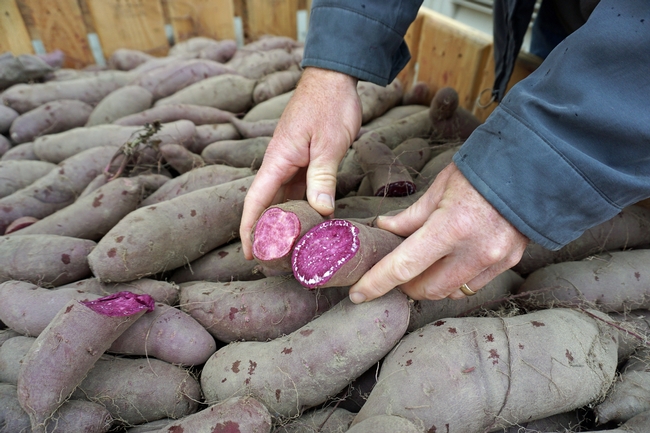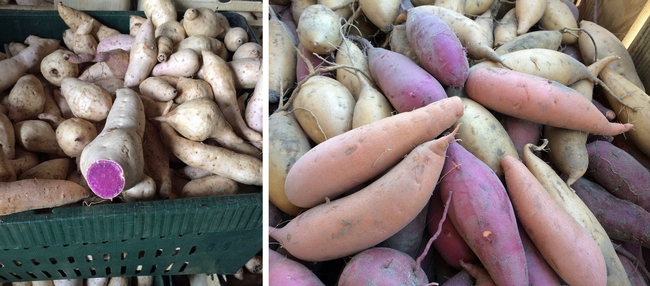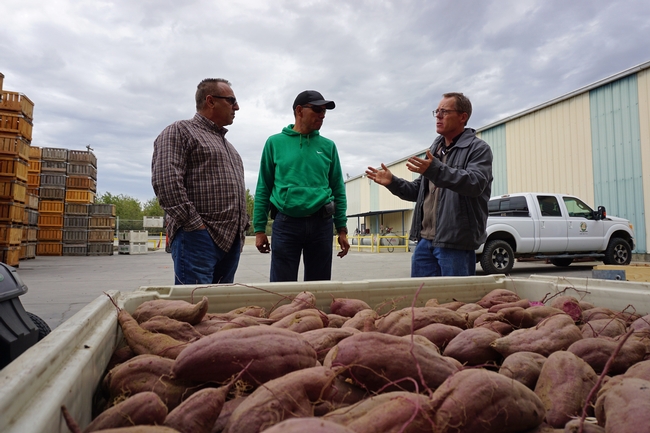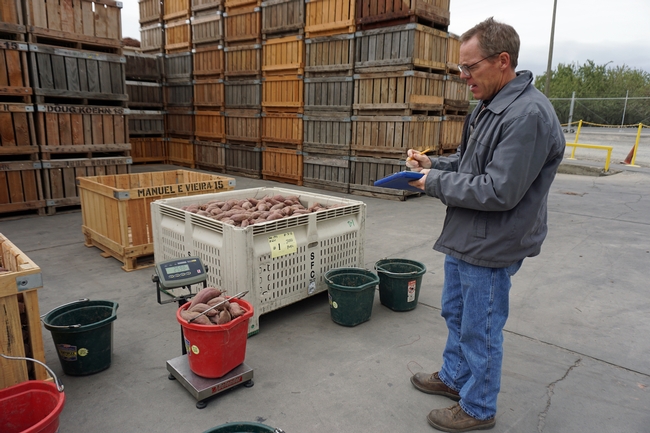
Posts Tagged: sweet potato
Vibrant purple sweet potatoes are a healthful Thanksgiving surprise
Candied sweet potatoes – dripping with butter, brown sugar and pecans – or a casserole of mashed sweet potatoes smothered with toasted marshmallows are common sides on the Thanksgiving table. These rich dishes belie the true nature of sweet potatoes, which are nutrient packed, low-glycemic root vegetables that can be a part of a healthy diet year round.
Research by UC Cooperative Extension advisor Scott Stoddard is aimed at making sweet potatoes an even more healthful and attractive food. Stoddard is working with sweet potato growers in Merced County to see if sweet potatoes with dusky purple skin and vibrant purple flesh, called purple/purples, can be grown by more farmers in California. The unusual color and health benefits command a higher price, opening a potentially profitable niche market.
“Purple flesh sweet potatoes have beta-carotene, like the more common orange varieties, plus anthocyanins,” Stoddard said. “It's like eating a handful of blueberries with your sweet potato.”
California is a significant producer of sweet potatoes. About 80 percent of the California crop – 16,000 acres – is grown in Merced County, on farms ranging from 5 acres up to several thousand acres. In 2015, the crop's value in Merced County was $195 million. About 1,000 acres are grown in Kern County and 2,000 acres in Stanislaus County. These locations have the sandy and sandy-loam soils ideal for sweet potatoes to develop their distinctive shape and smooth skin.
Sweet potatoes with purple flesh are not common, but they have been around for quite some time. They are the main type of sweet potato grown in Hawaii, for example. Several years ago, growers in Stokes County, N.C., selected a particularly beautiful and tasty cultivar, naming it the Stokes Sweet Potato and marketing nationwide with Frieda's Specialty Produce. In California, A. V. Thomas Produce in Livingston acquired an exclusive agreement with the company to grow and market Stokes purple/purple sweet potatoes.
“The number of acres of Stokes has really expanded in just a few years,” Stoddard said. "There is a lot of consumer interest in purple-fleshed sweet potatoes."
That doesn't close the door on purple/purples for California's other growers interested in the niche. Stoddard conducts field trials in cooperation with local farmers that include purple/purples. In one trial, 50 types of sweet potatoes of many different colors are being grown to determine whether they have key characteristics needed for local production. From there, he selects a limited number to grow in replicated trials, to determine their potential to produce a high yield, store well, and develop good size, shape, color and flavor. Of these, only one purple/purple made it into the replicated trial.
“In some purple/purples, the flavor can be off, or bitter,” Stoddard said. “We get rid of those right away.”
One of the cultivars in Stoddard's study, which goes by the experimental code number L-14-15-P, was bred in 2014 by Don La Bonte, a plant breeder at Louisiana State University, Baton Rouge. The potato has some good attributes, but lacks the uniform deep purple color of the Stokes variety.
“Unfortunately, it's probably not good enough to displace Stokes,” Stoddard said. “It's a good start, but we have to continue screening purple/purples to find a variety that offers disease resistance, good yield, and consistent deep purple flesh color."
Good eats
Sweet potatoes can be eaten raw or cooked. To eat raw, simply peel, cut into sticks and serve with low-fat ranch dressing or apple sauce for dipping. Grate fresh, uncooked sweet potatoes and add to burritos or tacos or sprinkle on salads for a sweet, nutritious crunch.
Cooked sweet potatoes can be eaten for breakfast, lunch or dinner, skin and all, plain or with a small pat of butter.
Microwaving is a great way to quickly prepare the vegetable. Wash potatoes and pat dry. Prick skin with a knife in 2 to 3 places. Cook on high for 5 minutes. Turn over. Then cook for another 5 minutes, more or less.
UC Cooperative Extension's sweet potato expert Scott Stoddard says he prefers his sweet potatoes baked.
“Baked is way better,” he said. “Baking gives time to convert the starch to maltose.”
Sweet potatoes are mostly starch, but have a special enzyme that breaks down starch into maltose when cooking. Slower cooking in the oven provides time for the conversion, imparting a subtly sweet caramelized flavor.
To bake, preheat the oven to 400 degrees. Line the lower oven rack with foil, then prick sweet potatoes with a fork and place directly on the middle oven rack, above the rack with foil. Bake 45 minutes for sweet potatoes 2 to 3 inches in diameter.
UC ANR and San Joaquin Valley cotton growers join forces to prevent sticky cotton in 2015

“It's like having an embarrassing social disease,” Betancourt said. “We want to do better, and we need your help.”
Betancourt was appealing to UC Agriculture and Natural Resources and other experts who were gathered with him at the California Cotton Ginners and Growers Association annual meeting in Visalia. UC ANR entomology specialist Larry Godfrey had begun the pest management session with a somber message. The whiteflies that cotton growers had been controlling reasonably well for more than 20 years was suddenly posing a tremendous challenge.
“I don't know what's up,” said Godfrey, who is housed in the Department of Entomology and Nematology at UC Davis. “It's a different critter.”
Betancourt attested to Godfrey's conclusions. He observed a few whiteflies in the field during the summer of 2013. It was a minor problem. In 2014, he decided to be more aggressive with monitoring and treating for the pest.
“I doubled down last year, but we had a bigger problem with whiteflies,” he said. “I thought, ‘This just can't happen!'”
Whiteflies feed on plant sap and then excrete honeydew. The sweet, sticky honeydew settles on open cotton bolls. If sticky cotton makes its way to spinning mills, it gums up the machinery. It's a scenario that mill managers won't soon forget.
Because of the San Joaquin Valley's long, dry growing season, cotton farmers have earned a reputation for high-quality, high value cotton, said Roger Isom, the CEO of the California Cotton Growers and Ginners Association. Sticky cotton is major concern.
“It happened in Arizona and almost destroyed the state's cotton industry,” Isom said. “Sticky cotton brings mills to a standstill. If they start getting sticky cotton, they'll decide to stop buying from the area where it came from. And once you have the stigma, it's extremely hard to overcome.”
Godfrey said the new biotype of sweet potato whitefly was first found in the San Joaquin Valley in July 1992. Certain areas required careful management, such as those closer to cities where it is warmer and the pest can spend the winter on ornamental plants. Farmers were able to deal with it.
“Then, in 2013 and 2014, populations of whitefly developed in other parts of the San Joaquin Valley, not only adjacent to cities. We don't know why or exactly what is going on,” Godfrey said.
Initially, pest control advisers suspected the whitefly was developing pesticide resistance. UC ANR research trials at the UC West Side Research and Extension Center in Five Points and the Shafter Research Station in Kern County showed that insecticides used at label rates were still able to knock down the pest.
“What we did notice was we had a lot more whitefly and we started seeing them earlier than normal,” Godfrey said. “It certainly makes it more expensive to grow cotton and, if not controlled, makes sticky cotton.”
What's worse, the reputation of cotton in a whole area is tarnished if one or two farmers mismanage the pest and their cotton gets into commercial channels.
“In my area, we have a problem right now and it's not just my problem,” Betancourt said. “Everybody who has whiteflies has to deal with them. We have a reputation to uphold.”
All the growers who send cotton to the same gin as Betancourt will be invited to meet with UC ANR scientists Godfrey and Pete Goodell, integrated pest management advisor, to strategize about whitefly control for 2015.
Godfrey said they will emphasize the importance of early management and treatment, sharing lessons learned in Arizona.
“The scientists there did a lot of really good work on quantifying an infestation and determining when to treat,” Godfrey said. “We are taking their recommendations and studying where we might need to make changes due to California growing conditions.”
Goodell said it is critically important for growers to take the threat of sticky cotton seriously.
“We can't reiterate enough, once you develop a poor reputation for sticky cotton, it sticks with you,” Goodell said.
An initiative to manage endemic and invasive pests and diseases is part of UC Agriculture and Natural Resources Strategic Vision 2025.
Additional resources:
Goodell webinar on Preventing Sticky Cotton.
Godfrey research report PDF attached below:
Management of late-season infestations of cotton aphids and sweet potato whiteflies (strain B) in Pima cotton in the San Joaquin Valley
Enjoy California sweet potatoes around the clock and calendar

California is a significant producer of sweet potatoes. About 90 percent of the California crop – 18,000 acres – is grown in Merced County, on farms ranging from 5 acres up to several thousand acres. In 2011, the crop’s value statewide was $125 million.
However, you probably won’t find sweet potato farmers at your local farmers market.
“Even smaller growers tend to work with a packing shed and have their crops combined with others and marketed,” said Scott Stoddard, UC Cooperative Extension advisor in Merced County.
A few years ago, when sweet potato fries began showing up at high-end restaurants and fast food chains across the country, the U.S. and the California sweet potato industries overestimated the future growth in sweet potato consumption, Stoddard said. In addition, improvements in growing practices boosted yield per acre, leaving the country with something of a sweet potato glut. Currently, acreage is inching down again as growers balance supply with demand.
Most sweet potato breeding programs are conducted in the South, such as Louisiana and North Carolina, but the characteristics sought in that part of the country are different than California. Stoddard is conducting specialized variety trials in California to select varieties with red, purple or garnet skin.
“In California, we are going for a red-skinned sweet potato,” Stoddard said. “Especially, a red-skinned variety that stores well.”
Some people incorrectly believe that sweet potatoes with moist orange flesh are yams. True yams can be found elsewhere in the world, but in the U.S., a sweet potato is a sweet potato, whether the flesh is orange, yellow or white and whether the skin is tan, dusty pink or garnet red.
Sweet potatoes are a featured California crop in Dirt Fresh News, a monthly newsletter produced by UC Cooperative Extension in Stanislaus County that introduces school children to fresh, locally grown food. The newsletter says sweet potatoes are a good source of potassium, fiber, beta-carotene and vitamins B-6, E and C.
To eat them raw, simply peel, cut into sticks and serve with low-fat ranch dressing or apple sauce for dipping. Grate fresh, uncooked sweet potatoes and add to burritos or tacos or sprinkle on salads for a sweet, nutritious crunch.
Baked sweet potatoes can be eaten for breakfast, lunch or dinner, skin and all, plain or with a small pat of butter.
“Microwaving is a great way to save energy if you are just baking 1 or 2 potatoes,” the newsletter says. “Wash your potatoes and pat dry. Prick skin with a knife in 2 to 3 places. Cook on high for 5 minutes. Turn over. Then cook for another 5 minutes, more or less.”
Following are recipes from the Sweet Potato Council of California:
Warm sweet potato and green bean salad
3 medium sweet potatoes, cooked, pared and cut into ¼-inch slices (about 2 lbs.)
½ pound fresh whole green beans
1 small red onion, halved and sliced
1 clove garlic, minced
2 tablespoons vegetable oil
1 cut watercress springs (optional)
1 tablespoon red wine vinegar
½ teaspoon salt
¼ teaspoon freshly ground pepper
In large skillet over medium-high heat, brown sweet potatoes and cook green beans with onion and garlic in oil until crisp-tender. Remove from heat. Stir in remaining ingredients. Service warm. If esired, top with Parmesan cheese shavings.
Sweet potato Leek Soup
1 bunch leeks, white and light green portion
2 tablespoons butter or margarine
2 fresh sweet potatoes
4 cups water
1 teaspoon salt
1/2 teaspoon thyme
1/2 cup heavy cream
1 tablespoon lemon juice
1/4 teaspoon white pepper
1 pinch cayenne or ground red pepper
Slice leeks and saute in butter until soft. Thinly slice sweet potates; add to leeks; saute 3 minutes. Add water, salt and thyme. Bring to a boil; reduce heat and simmer, partially covered, 20 - 25 minutes, stirring occasionally, until vegetables are very soft. Puree and strain. Add cream, lemon juice, white and red pepper. Adjust seasonings to taste. For garnish, julienne additional leek and sweetpotato into 3/4" strips; saute in 2 tablespoons butter until crisp-tender. Just before serving, stir into soup. Makes 4 to 6 servings.
New reason to give thanks for the sweet potato
What if you could significantly improve the nutritional quality of your diet, just by switching one of the vegetables you eat every day?
In parts of Africa, some people are doing just that by switching from yellow or white sweet potatoes to orange-fleshed varieties.

That orange color signifies the potato’s beta-carotene content, which our bodies convert to vitamin A. Vitamin A deficiency is the leading cause of preventable blindness in children and is crucial to the survival of children and pregnant women, according to the World Health Organization.
So scientists and organizations who are working to increase vitamin A in African diets have turned to the orange-fleshed sweet potatoes as a potential solution, wherever light-colored sweet potatoes loom large.
With funding from the U.S. Agency for International Development, Horticulture CRSP is working in Ghana to strengthen the entire value chain of orange-fleshed sweet potato — from farmers and food processors, to markets and consumers.
Though Horticulture CRSP is led by UC Cooperative Extension’s Elizabeth Mitcham at UC Davis, this project includes a team of international researchers with experts from Tuskegee University, Penn State and Ghana University. Together, they are working to:
- provide farmers with germplasm and best management practices
- teach women entrepreneurs to process orange-fleshed sweet potatoes into bread flour, purees and dehydrated chips
- formulate a weaning food for babies that incorporates orange-fleshed sweet potatoes with other, traditional foods
Find out more about this Horticulture CRSP sweet potato project (including a 2-minute video).
Did you know? In 2011 California was the second largest producer of sweet potatoes in the United States, with North Carolina leading the way (source). Find out more in this related ANR News Blog post or from the UC Vegetable Research and Information Center.
Survey identifies 19 produce candidates for a farm-to-WIC program
A new federal voucher that gives low-income women access to a range of fruits and vegetables could provide unique new marketing opportunities for California growers.
In 2009, the federal Special Supplemental Nutrition Program for Women, Infants and Children (WIC) began distributing monthly cash vouchers to low-income women with children to buy fruits and vegetables. The program reaches almost half of the infants and one-quarter of children under 5 years old in the United States.
A team of UC Cooperative Extension (UCCE) researchers and nutrition advisors has been exploring the possibility of developing a farm-to-WIC program that would link these low-income consumers with local growers. The purpose of such a program would be to increase the consumption of a wide variety of fresh produce, with a focus on locally grown produce when available.
UCCE conducted a survey of produce preferences and buying habits among WIC participants in Tulare, Alameda and Riverside counties in 2010. The full study is published in the January-March 2012 issue of California Agriculture journal.
Based on the results, the UCCE team developed a list of 19 produce items to promote in a possible new farm-to-WIC program. They are:
|
|
|
Although mustard greens and collards were not popular across all sites, the advisors gauged a potential market in Alameda County, so these were retained. Based on write-in responses, oranges were also added.
In California, which has the nation's largest WIC program, 82 local agencies serve about 1.43 million participants at 623 local centers, and WIC participants can redeem their monthly vouchers at 4,000 grocery stores statewide. About 40 percent shop at WIC-only stores, which stock and sell only WIC-authorized foods.
Stocking produce is relatively new to WIC-only stores; before rollout of new WIC food packages in October 2009, these stores were only required to stock limited amounts of fresh carrots. In the survey, most WIC participants (58 percent to 72.3 percent) responded that their preferred stores offered many choices, but fewer participants (18.5 percent to 41 percent) rated the produce quality as “excellent.” Key factors determining purchase decisions were produce quality and freshness, and nutrient value (vitamins and minerals). Cost was relatively less important, possibly because WIC participants procure the produce with the vouchers.
The list has served as a starting point for discussions with growers and WIC vendors.
“The survey showed that WIC participants were interested in purchasing fresh produce with better quality and more variety,” wrote lead author Lucia L. Kaiser, Cooperative Extension specialist in the UC Davis Department of Nutrition, and co-authors, in California Agriculture. “Some WIC participants that we surveyed said they avoided shopping at WIC-only stores in part because these interests were not met.”

A dish made with nopales (cactus pads).




